Over the past few years, NVMe drives have been gradually increasing their place in the storage market. The main reason for this is how drastically they improve the storage I/O path, which can significantly improve overall system performance. The Toshiba OCZ RD400 is OCZ’s first NVMe SSD targeting the consumer demographic, specifically enthusiasts and gamers. Casting a wider net, the RD400 also includes an M.2 PCIe adapter for those desktop PCs that do not have an M.2 slot.
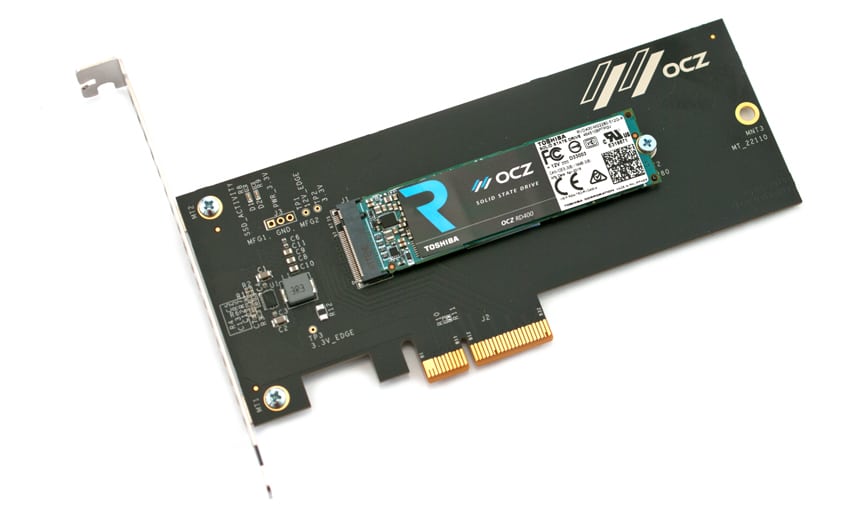
OCZ is quoting sequential read speeds up to 2,600MB/s, sequential write performance up to 1,600MB/s, and up to 210,000 IOPS @4KiB of random read performance. One of the most valuable aspects of OCZ SSDs is their Advanced Warranty Program (previously called the ShieldPlus Program), which virtually eliminates the annoyance that is inherent in most support and warranty claims. This hassle-free program, which comes with all OCZ SSDs, ships a replacement drive with no return shipping costs to consumers with defective products.
Backed by a 5-year warranty, the Toshiba OCZ RD400 M.2 comes in capacities of 128GB, 256GB, 512GB, and 1TB. We will be looking at the 512GB unit in this review.
Toshiba OCZ RD400 Specifications
- Interface: PCIExpress, NVMe
- Flash Components: MLC
- Capacities: 128GB, 256GB, 512GB, 1,024GB
- MTBF: 1.5M hours
- Product Health Monitoring: Self-Monitoring, Analysis and Reporting Technology (SMART) Support
- Performance Optimization: TRIM, Idle Time Garbage Collection
- Performance:
- 128GB
- Sequential Read: Up to 2,200 MB/s
- Sequential Write: Up to 620 MB/s
- Random Read: Up to 170,000 4KiB IOPS
- Random Write: Up to 110,000 4KiB IOPS
- Endurance: 74 TBW (5 Years)
- 256GB
- Sequential Read: Up to 2,600 MB/s
- Sequential Write: Up to 1,150 MB/s
- Random Read: Up to 210,000 4KiB IOPS
- Random Write: Up to 140,000 4KiB IOPS
- Endurance: 148 TBW (5 Years)
- 512GB
- Sequential Read: Up to 2,600 MB/s
- Sequential Write: Up to 1,600 MB/s
- Random Read: Up to 190,000 4KiB IOPS
- Random Write: Up to 120,000 4KiB IOPS
- Endurance: 296 TBW (5 Years)
- 1,024GB
- Sequential Read: Up to 2,600 MB/s
- Sequential Write: Up to 1,550 MB/s
- Random Read: Up to 210,000 4KiB IOPS
- Random Write: Up to 130,000 4KiB IOPS
- Endurance: 592 TBW (5 Years)
- 128GB
- Software: SSD management software: SSD Utility and Command Line Online Update Tool (CLOUT)
- Dimension (L x W x H):
- 128 GB, 256 GB, 512 GB: 80 x 22 x 2.23 mm
- 1024 GB: 80 x 22 x 3.58 mm
- AIC: 157.64 x 105.51 x 17.2 mm
- Power Consumption (Active):
- 128 GB, 256 GB, 512 GB: 6.0 W (typ.)
- 1024 GB and AIC: 6.4 W (typ.)
- Power Consumption (Power State 5): 6.0 mW (typ.)
- Warranty: 5 years
Design and Build
The front side of OCZ RD400 M.2 features a sticker that is branded with the OCZ and Toshiba logos, as well as the product name and all the drive’s certifications. Because the M.2 is much smaller than the traditional 2.5 inch SSD (2.3mm in thickness), it can be used in much smaller form factor systems.

The side opposite of the connectors is equipped with an M-key notch to denote PCIe Gen3x4L and SATA compatibility. All capacities use a Toshiba controller, Toshiba 15nm MLC NAND, and Samsung DRAM.

Consumer Synthetic Benchmarks
All consumer SSD benchmarks are conducted with the StorageReview HP Z620 Workstation. We compared the OCZ RD400 M.2 with the following drives:
- Samsung SM951-NVMe M.2 SSD
- Samsung SM951 PCIe M.2 SSD
- Samsung 850 EVO M.2 SSD
- Samsung 950 PRO M.2 SSD
All IOMeter figures are represented as binary figures for MB/s speeds.
In our first test, we measured 2MB sequential performance. Here, the RD400 recorded a strong 1,934MB/s in read and 1,475MB/s in write, putting it at the front of the pack in read speed.
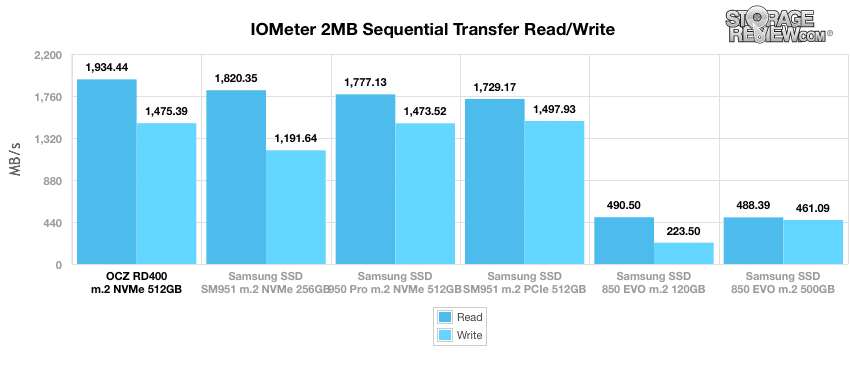
In the 2MB random transfer performance test, the OCZ-Toshiba drive boasted another impressive read and write performance, with 1,771MB/s and 1,446MB/s respectively. The next best drive was the Samsung SSD SM951 m.2 NVMe 256GB, which posted 1,417MB/s read and 1,076MB/s write.
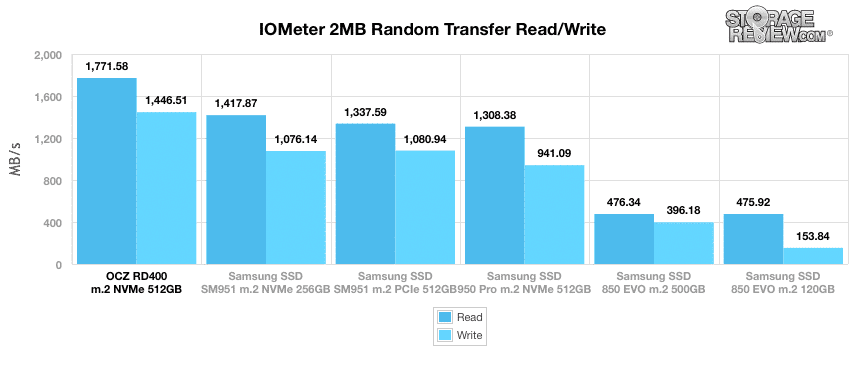
When switching to smaller 4K random transfers, the RD400 slowed down significantly. Here, the drive recorded 28MB/s read and 164MB/s write.
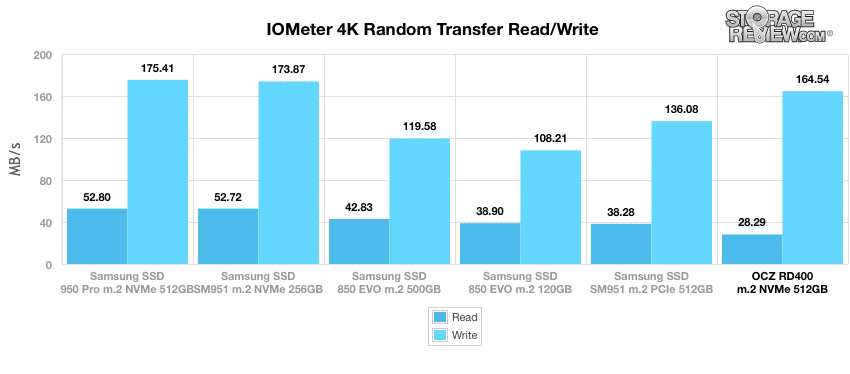
Looking at throughput told a similar story, with the RD400 recording 7,241 IOPS read and 42,122 IOPS write. The Samsung SSD 950 Pro m.2 NVMe 512GB was the top performing drive here with 13,516 IOPS read and 44,903 IOPS write.
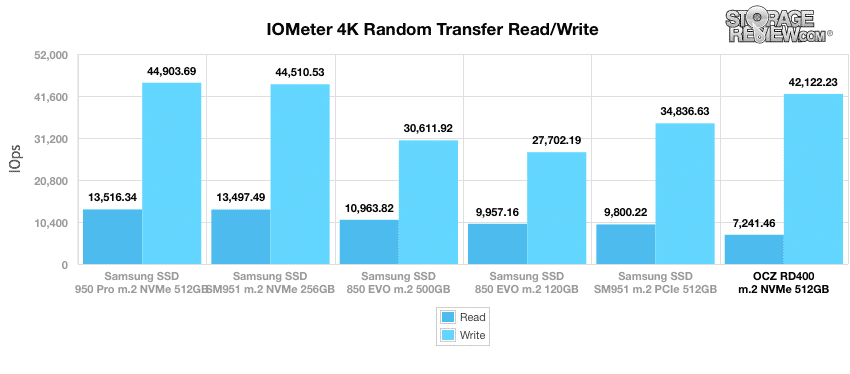
When looking at 4K write latency (both the average and maximum readings) the RD400 kept up with the rest of the NVMe drives in average read latency with 0.0233ms. However, it posted 31.01ms in maximum latency. The Samsung 950 Pro showed top average latency readings with 0.0219ms, while the SM951 NVMe showed the best results in max latency with just 0.58ms.
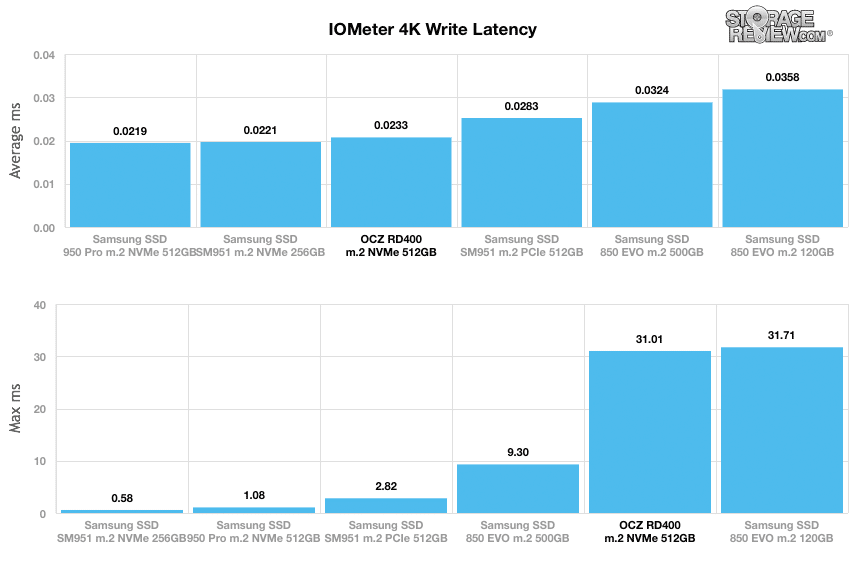
In our next 4K test, we looked at a workload with 100% write activity, which scales from 1QD to 64QD. In the aligned write scenario, the RD400 picked up its performance with 41,956 IOPS at 1QD with a whopping 132,672 IOPS at 64QD. This was far and beyond the best performing drive.
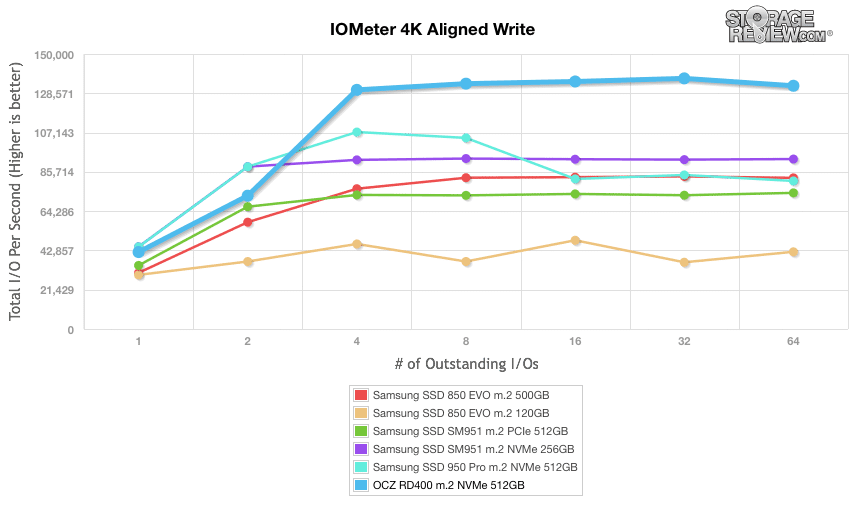
Moving to our aligned read test, the RD400 moved down the leaderboard slightly with 177,479 IOPS at 64QD. The difference between the two top M.2 SSDs was less than 1,000 IOPS (Samsung SSD SM951 M.2 NVMe 256GB and Samsung SSD 950 Pro M.2 NVMe 512GB).
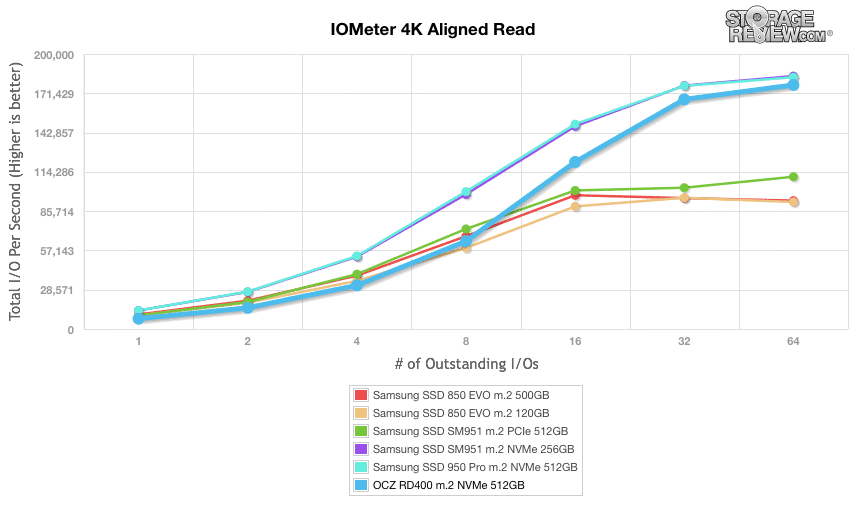
Our last series of synthetic benchmarks compare the hard drives in a series of server mixed-workloads with a queue depth ranging from 1 to 128. Each of our server profile tests has a strong preference towards read activity, ranging from 67% read with our database profile to 100% read in our web server profile.
The first is our database profile, which uses a 67% read and 33% write workload mix primarily centered on 8K transfer sizes, which shows the RD400 with 7,816 IOPS at 1QD and 107,006 IOPS at 64QD. This was just behind the SM951 256GB’s 108,711 IOPS at 64QD.
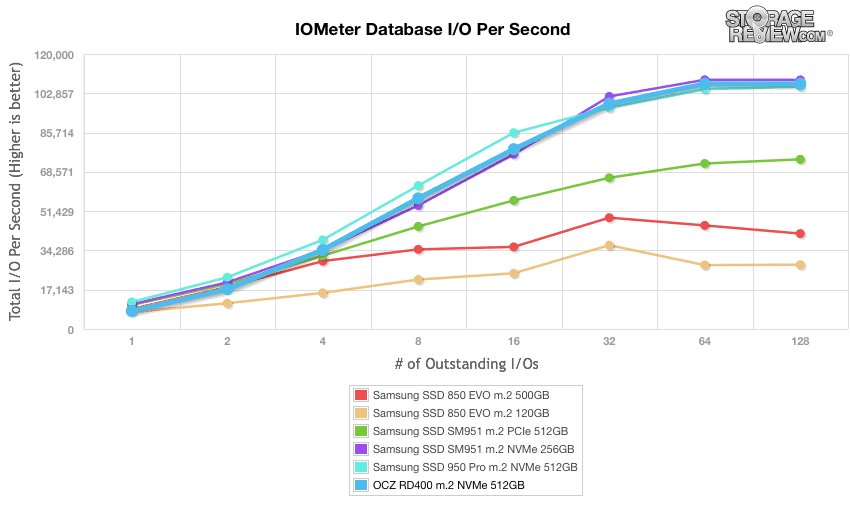
Our web server profile is read-only with a spread of transfer sizes from 512-byte to 512KB. Here, the RD400 posted results well below the rest of the NVMe drives with 5,813 IOPS at 1QD and 56,557 IOPS at 128QD. The SM951 NVMe 256GB took top honors once again.
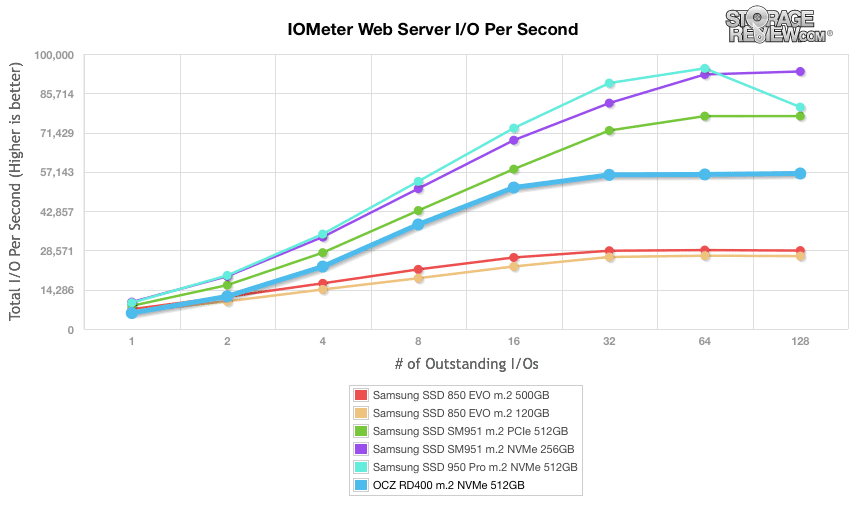
The next profile looks at a file server, with 80% read and 20% write workload spread out over multiple transfer sizes ranging from 512-byte to 64KB. The RD400 posted a range of 7,286 IOPS to 81,575 IOPS.
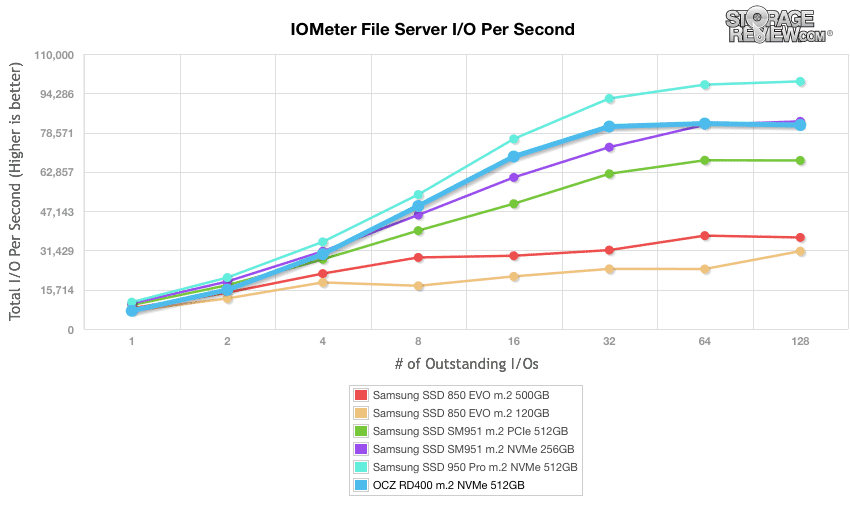
Our last profile looks at workstation activity, which is comprised of a 20% write and 80% read mixture using 8K transfers. Here, the RD400 posted a range of 7,153 IOPS to 114,901 IOPS, placing it right in the middle of the leaderboard (but last among the NVMe comparables).
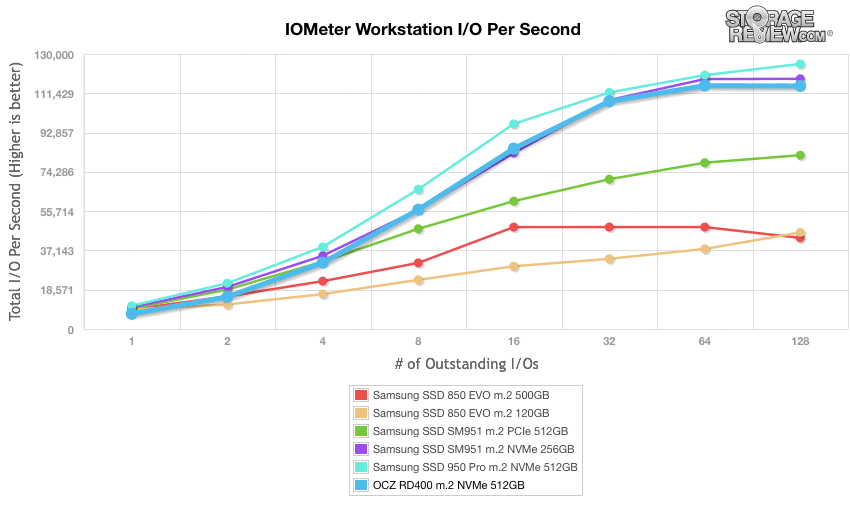
Consumer Real-World Benchmarks
For the average consumer, trying to translate random 4K write speeds into an everyday situation is pretty difficult. It helps when comparing drives in every setting possible, but it doesn’t exactly work out into faster everyday usage or better game loading times. For this reason we turned to our StorageMark 2010 traces, which include HTPC and Gaming traces to help readers find out how a drive might rank under these conditions.
The first real-life test is our HTPC scenario. In this test we include: playing one 720P HD movie in Media Player Classic, one 480P SD movie playing in VLC, three movies downloading simultaneously through iTunes, and one 1080i HDTV stream being recorded through Windows Media Center over a 15 minute period. Higher IOPS and MB/s rates with lower latency times are preferred. In this trace we recorded 2,986MB being written to the drive and 1,924MB being read.
In our HTPC profile, the RD400 posted results noticeably lower than the other NVMe drives (though still extremely fast) with 981.23MB/s and 21,024 IOPS as well as 0.321ms in average latency.
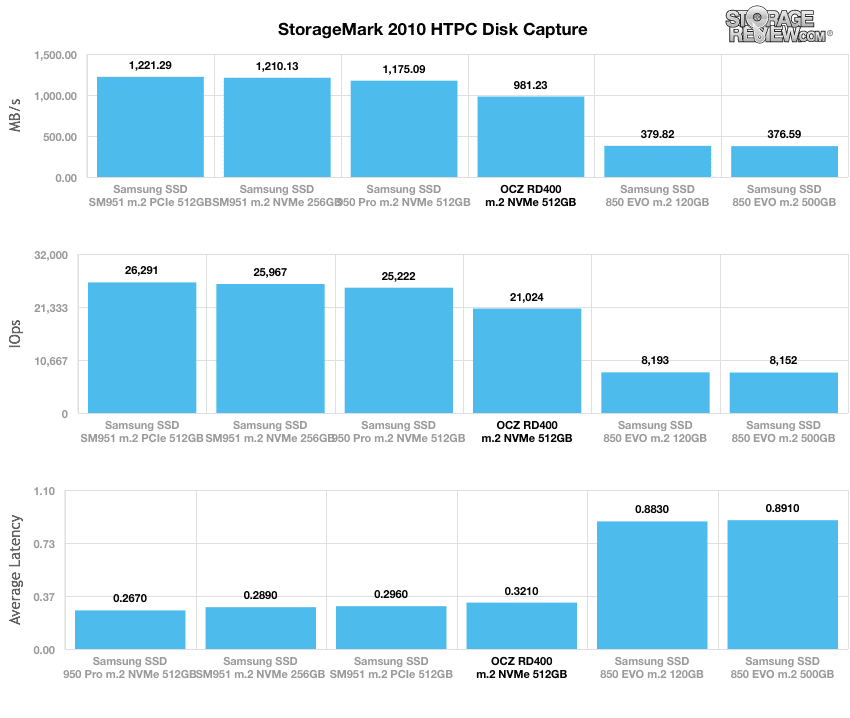
Our second real-life test covers disk activity in a productivity scenario. For all intents and purposes, this test shows drive performance under normal daily activity for most users. This test includes: a three hour period operating in an office productivity environment with 32-bit Vista running Outlook 2007 connected to an Exchange server, web browsing using Chrome and IE8, editing files within Office 2007, viewing PDFs in Adobe Reader, and an hour of local music playback with two hours of additional online music via Pandora. In this trace we recorded 4,830MB being written to the drive and 2,758MB being read.
In our Productivity trace, there was an even larger discrepancy between the RD400 and the other NVMe drives, as it posted 20,123 IOPS, 618MB/s, and 0.39ms in average latency.
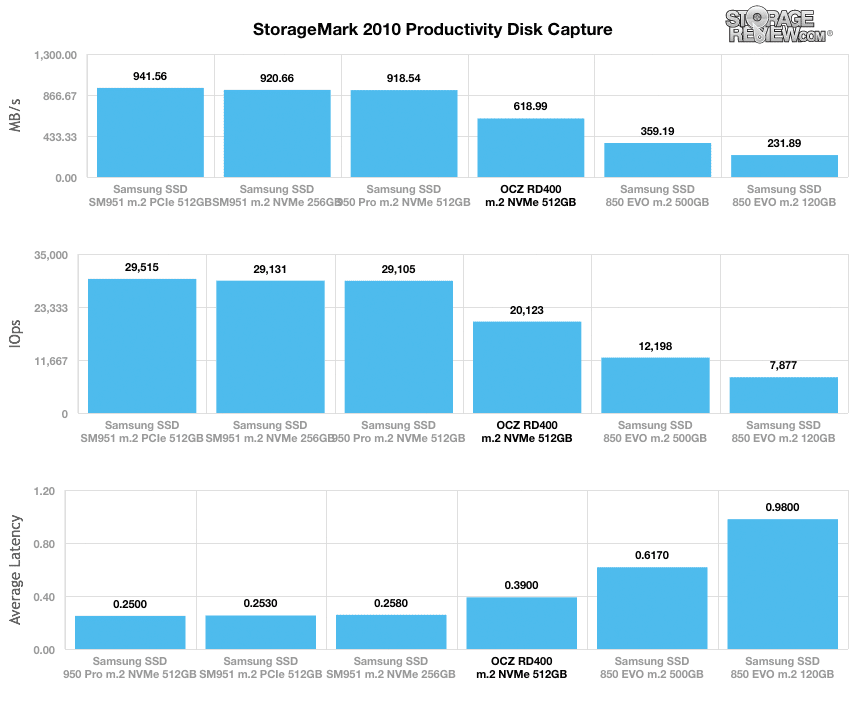
Our last real-life test covers disk activity in a gaming environment. Unlike the HTPC or Productivity trace, this one relies heavily on the read performance of a drive. To give a simple breakdown of read/write percentages, the HTPC test is 64% write and 36% read, the Productivity test is 59% write and 41% read, while the gaming trace is 6% write and 94% read. The test consists of a Windows 7 Ultimate 64-bit system pre-configured with Steam, with Grand Theft Auto 4, Left 4 Dead 2, and Mass Effect 2 already downloaded and installed. The trace captures the heavy read activity of each game loading from the start, as well as textures as the game progresses. In this trace we recorded 426MB being written to the drive and 7,235MB being read.
In our read-intensive Gaming trace, the RD400 picked up its pace significantly, posting 1,463MB/s, 30,129 IOPS, and a leading average latency of 0.221ms. This placed it at the top of the leaderboard, which is unsurprising since OCZ touted one of its use cases as a gaming drive.
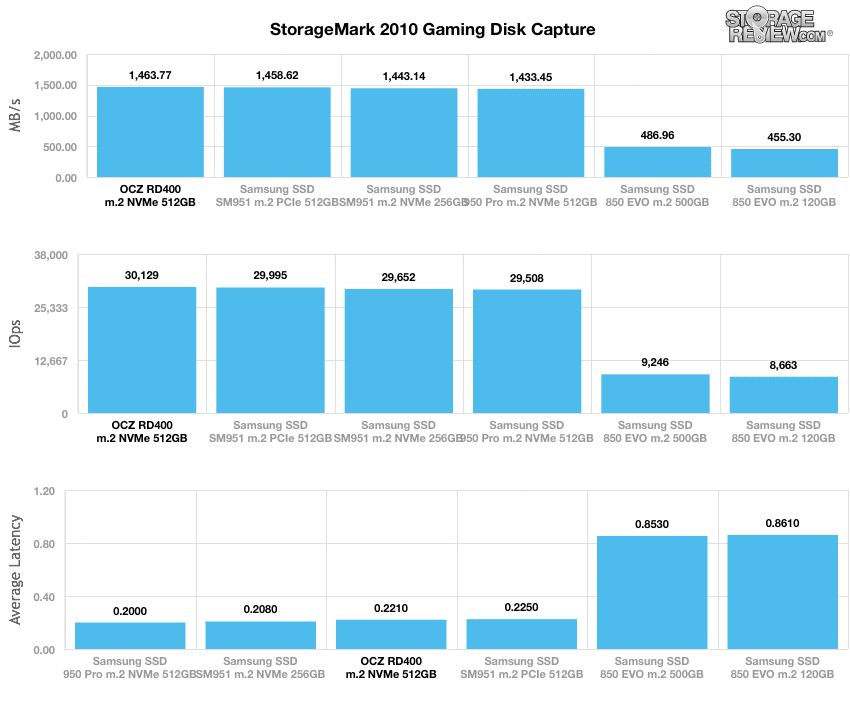
Conclusion
Though somewhat of a mixed bag in performance, OCZ’s RD400 first venture into the consumer NVMe SSD market looks to be a successful one. The RD400 comes in an M.2 form factor in capacities up to 1TB. OCZ also bundles an M.2 PCIe adaptor add-in-card, allowing desktop users to leverage the M.2 devices in older platforms, although the SSD itself can be removed and installed directly in systems with a native slot on the motherboard.
During our 2MB sequential benchmark, the RD400 boasted an impressive 1,934MB/s read and 1,475MB/s write, easily topping the rest of the tested drives. In random performance, the OCZ drive delivered another impressive read and write performance, with 1,771MB/s and 1,446MB/s respectively. In comparison, the next best drive was the Samsung SSD SM951 NVMe, which posted well behind the RD400 with 1,417MB/s read and 1,076MB/s write.
However, our 4K random transfer benchmarks told a different story. Here the RD400 drive recorded 28.29MB/s read and 164.54MB/s write, while throughput showed 7,241 IOPS read and 42,122 IOPS write. During our 4K aligned read and write workloads, the RD400 improved significantly, as it scaled from 22,767 IOPS up to 60,585 IOPS and 7,110 IOPS to 85,811 IOPS, respectively. These results placed the Toshiba-OCZ drive in the middle of the pack. Our series of server mixed-workloads told a similar story, as the drive consistently placed in the upper middle tier of the leaderboard as well. In our workload test with 100% write activity, the RD400 picked up its performance with 41,956 IOPS at 1QD and an impressive 132,672 IOPS at 64QD, placing it at the top of the leaderboard. During our aligned read, the RD400 slowed down with 177,479 IOPS at 64QD.
When looking at our real-world consumer benchmark results, the RD400 continued its trend of uneven performance, placing at the bottom of the pack during both our HTPC (81MB/s and 21,024 IOPS) and Productivity (20,122 IOPS and 618MB/s) traces. However, during the Gaming workload, the RD400 showed much better performance, boasting 1,463.77MB/s and 30,129 IOPS, taking top honors. The net result is the drive has some very good attributes and is a respectable contender in this category. Acceptance in this new market will likely be determined by pricing; if OCZ can provide leadership there, the RD400 has a bright future ahead.
Pros
- Impressive performance in certain areas (e.g., 2MB and gaming traces)
- Industry-leading warranty
- PCIe adapter included
Cons
- Overall uneven performance
Bottom Line
The Toshiba OCZ RD400 is an NVMe SSD that packs ample performance (category leader in a few spots) and up to 1TB capacity in a small M.2 form factor.




 Amazon
Amazon